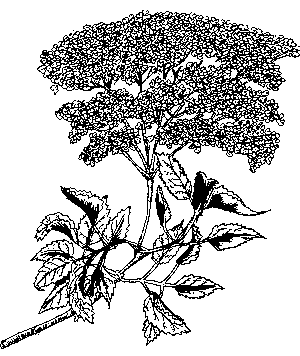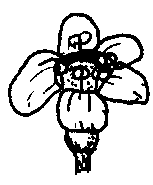Contents
Characteristics of elder tree
What is an elder tree?
Common English name: Elder, European black elder (tree); Eldelberry, Common elderberry, Black elderberry, European elderberry (fruit)
Scientific noun: Sambucus nigra L.
Etymology: Etymologically derived from the Greek “Sambuca” , a musical instrument similar to a harp made by the Romans with the wood of this tree.
Family. Elder family -Caprifoliaceae
Habitat: In woods, by the side of the rivers and streams and humid hedges.



Detail of an elderberry branch with leaves and an inflorescence. Next fruits and flowers. Drawings by courtesy of : ©Dibujosparapintar
Description of elder tree
Shrub – tree up to 10 m. Ligneous stems, gray brown like cork. There is a second crust called phloem that appears when the plant is superficially torn
Composite leaves, pinnate till 12 cm long. 5- 7 leaflets, toothed and ovate.
Flowers in inflorescences, similar to umbels, very flat, till 20 cm wide. Cream corolla, about 5 mm.
Picking and storing elder medicinal parts

Spring and Autumn are the best season to pick the flowers. Flowers must be dried in the shade and kept in a dry and dark place.
The fruits are collected at the end of the summer or in the fall, when they are very black and bright, and hang from the branches. or prepare with them a syrup.
Traditionally, leaves and bark have been used, however, for toxicity reasons, it is not recommended to consume bark and elder leaves.
The leaves of the young shoots were collected in spring.
To obtain the bark, the tree was torn a little and the second bark or phloem (liber) was obtained, which was collected in the autumn, dried in the sun and preserved in a dry and airtight container.
Elderberry composition: active ingredients

- Flowers: mucilage, choline, essential oil (0.03-0.15%) with palmitic, linoleic and linolenic acids, linalool, nerol, geraniol, alpha terpineol, alpha amirin, beta amirin, betulin, campesterol, lupeol, ursolic acid, flavonoids (1-2%) rutin, hyperoside, astragaloside, potassium nitrate, chlorogenic acid, caffeic acid, tannins
- Fruits (elderberries): fiber, glucose, fructose, potassium, malic acid, citric acid, phosphorus, magnesium, vitamin C, calcium, sodium, oxalic acid, iron, thiamine (vitamin B1), riboflavin (vitamin B2), niacin (vitamin B3), biotin (vitamin B7), manganese, zinc, anthocyanins (purple) essential oil (0.01%)
- Immature or green fruits: They contain a high amount of sambunigrin (0.8%), a toxic principle. Green fruits should not be consumed.
- Bark: sambunigrin (toxic principle), oleanolic acid, betulinic acid, alpha-amirin, beta-sitosterol, phytohemagglutinins
- Leaves: tannins, rutin, pectin, sambunigrin (toxic principle), ursolic acid
- Seeds: They are very toxic, having found sambunigrin, prunasoside, sambunigroside, cardiotoxic hemagglutinins. When fruits are consumed, the seeds should be removed.
History of elderberry: Tradition, rituals and legends
Elderberry is one of the trees with the most magical potential in European culture. According to Christian tradition, it has historically been considered as the emblem of grief and death. The reasons must be sought in historical facts. This was the tree on which Judas was hung and the logs of the cross of Jesus Christ appear to be made of elderberry.
From here, there are many cultures that have considered this tree as cursed and have tried to keep their citizens away from it. Thus, for example, among the gypsies there is a belief of not using it in their fires.
In the Teutonic tradition it was related to the nymph of the Hyldemoer forests, which lived in its branches and did not let them cut it by persecuting those who did and enchanting them. They say he got into the homes of those who had put their little ones to sleep in cribs made with their wood and bothered them until they were taken from them.
Within this same culture, the undertakers measured the dead to build their coffins, with rods cut from this tree. But beliefs about this species are not all negative, but magical. For example:
- The Serbs marry carrying a twig of theirs, as a sign that the union will be lasting.
- Among the Anglo-Saxons there was the belief of picking up their leaves on the last day of April and hanging them over the doors, to prevent the witches from entering.
- In Tyrol, if a cross made from elderberry is placed on top of a tomb, and it blooms, the dead man’s soul rests happily.
For more related information, we recommend the very interesting article about the magical properties of elderberry.
Properties of elder wood
Elder wood is very hard. For this reason, it has been highly valued at the time of the construction of agricultural tools or also in joinery. Sometimes it has been used as a substitute for boxwood.
It is said that the same word elder comes from the Greek sambuké, which means flute. The reason is that in the past the interior of the branches was emptied so that there was a hollow tube with which the flutes were made.
![]() More information on elder
More information on elder








